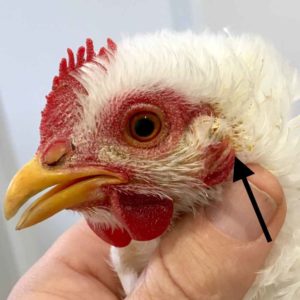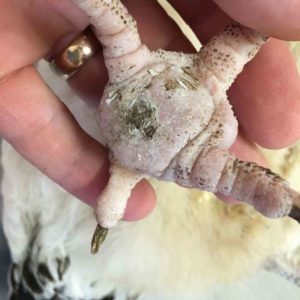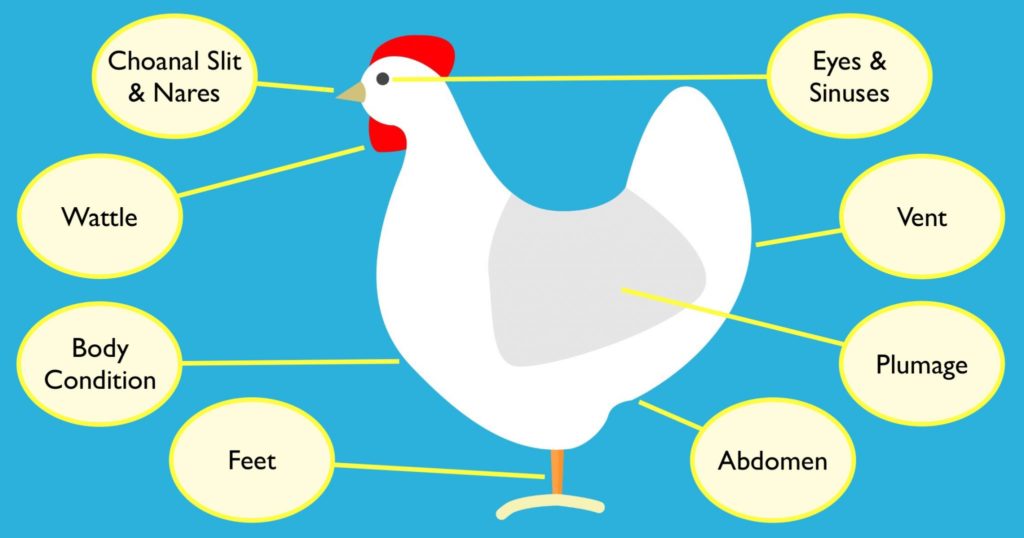Updated November 29, 2020
Most people can tell if a dog or cat is sick. It’s not too hard with ferrets either. All of these are predator species and have no reason to hide their illnesses.
Then there are the prey species, like rabbits, guinea pigs and birds. They deliberately hide signs of illness. They even pretend to eat! Most of the time what looks like ‘sudden death’ or a ‘heart attack’ is really the end of a long, slow illness we couldn’t see.
The good news is that you can tell. Here’s what to look for:
Body Condition
You can’t see if a chicken is thin, you have to feel for it. Here’s how:
How To Tell If A Chicken Is Thin
Feel for the ‘keel’. This is the part of the breastbone that forms a hard ridge running straight down the middle.
- Healthy, non-laying birds have a keel almost below the level of the breast muscle.
- Chickens during lay have a keel that stands out and sunken breast muscle. However there is still a rounded surface to the remaining muscle.
- Thin chickens have a concave or sunken feel to the breast muscle.
- Very thin chickens have a sharp feel to the keel and almost no breast muscle, and can die anytime.
Ask us to show you this next time you’re in or talk to your breeder.
Another way to tell if a chicken loses weight is to weigh everyone once a week and record the results. You can easily make a perch that sits on a set of scales.
General Behaviour
A healthy hen is bright & alert, inquisitive and active. They peck, scratch and explore continuously. You can’t see or hear them breathing unless you look closely.
A quiet, hunched bird who separates from the others is probably unwell.
Comb & Wattle
The comb is the red fleshy thing on top of the head. The wattle is the same, but under the chin.
These are excellent, quick telltales of health, especially if you have other hens for comparison. It’s good to know what’s the normal size and shape for your chicken’s breed.
However, all combs should be:
- Firm and upstanding (except the very big ones that are too heavy- mostly only roosters)
- A healthy pink or red colour: both a pale comb and a dark comb are signs of illness; beware a comb with dark, bluish edges.
Visit our gallery of chicken breeds to see normal combs and wattles.
Eyes & Ears

Should be fully open, clear, bright and free of discharge, with dark pupils. The third eyelid (nictitating membrane) should not be visible. Sick birds often look ‘sleepy’.
The ear lies just behind the eye. It should be clean, not like the picture here of an ear infection.
Sinuses
These are found above and below the eye. If you can see a semicircular swelling here, your hen has chronic sinusitis. There’s a picture of swollen sinuses on our guide to respiratory infections.
Beak & Nares
A hen who breathes with the beak open (except in hot conditions) is in serious trouble.
On the top at the base are the two nostrils (we call them nares -“nair-ees”). These should be clean, open and free of discharge or bubbles.
Choanal Slit
Unlike mammals, birds do not have a complete hard palate. The fissure in the top of the mouth with connects with the nasal passage is called the choanal slit (“ko-anal”). It’s easily seen by opening the beak and looking at the top of the mouth.
It should be clean and dry. While looking in the mouth, look down the throat quickly for anything out of place.
Plumage & Skin
Feathers in a healthy bird should sit flat and conform to the body shape. A bird sitting ‘fluffed up’ (except when sleeping) is usually quite unwell.
Lice are best found at the base of the feathers around the tail area and vent. They are surprisingly large and stay put.
Mites are small, and usually red. They often run onto your hands and cause nasty bites. Both lice and mites make the skin red and angry-looking
Hens during moult can look quite patchy but feather loss should be symmetrical and without other signs of illness.
Legs & Feet

Look for four things here:
- Scaly mite produces rough legs with hard irregular growths that can look like spurs (see a picture of scaly leg here)
- The skin should not have a bluish tone
- There should be no limp when walking
- Look under the feet for circular marks,sores or swelling where the weight sits between the toes. This is probably ‘bumblefoot’, and despite the silly name, it’s very serious.
Abdomen
The number one cause of death in backyard poultry is egg peritonitis – read more here. The only early clues are a loss of body condition, irregular egg production and a swollen abdomen.
A normal abdomen conforms to the shape of the bird. It shouldn’t bulge or have a hard or fluidy feel. You probably need to compare this to another hen.
Vent & Droppings
This is the single outlet for faeces, urine and eggs. Look for matting of faeces which may indicate diarrhoea.
Droppings also have a story to tell. They should have a formed, solid faecal component, usually light green. Urine in birds is passed together in the form of solid white urate with very little wetness.
Eggs
The shell can tell you about oviduct and uterine disease. If eggshells become thin or bumpy, something’s wrong.
Remember that any drugs used to treat your chickens may make the eggs unfit for human consumption. Vets take this responsibility seriously and choose treatments with the shortest withholding period.
Good luck! Your observations should allow you to get your hen to a chicken-friendly vet with enough time to get the right treatment underway.
For more about chicken care, visit our guide to keeping chickens healthy.
Euthanasia and Humane Killing Of Poultry
One last word needs to be said on a subject no-one wants to talk about. We all love our chickens but one day their end will come. In my opinion, far too few chickens are euthanased correctly, and many are just left to suffer when a humane death is available.
Commercial poultry are often euthanased via decapitation, neck dislocation or carbon dioxide gassing. I’m not going to argue with these methods, although there is no doubt some brief distress or pain will occur with each. As long as it’s quick and efficient, it’s still OK.
‘Euthanasia’ doesn’t just mean killing. It means providing a ‘good death’. Even if you never see us in the life of your chicken, we hope we can help at the end.
The problem backyard chicken owners face is that it’s often the first time. All authorities on animal welfare agree that these methods are only humane if performed by skilled operators. Too often a chicken is only partially decapitated or sustains a non-fatal neck injury before escaping. None of us wants that.
A chicken vet should have a setup in place to humanely despatch sick chickens. We use a large chamber with anaesthetic ports which is connected to an inhaled anaesthetic machine. The chicken is placed inside, often with the owner nearby, and we pipe in isoflurane until the chicken is unconscious. We then administer a lethal overdose of barbiturate.
Birds are extremely sensitive to gases and the process is quick and relatively stress-free.
To encourage humane euthanasia, we would like to offer to charge no more than a normal consult fee for the euthanasia process. Please note that this is not normal charging so please let us know when you make the appointment if you have read this.
This offer also only applies if you take your chicken home afterwards. However, please remember that poultry are classified differently from pet animals and therefore home burial is usually not permitted in your state. Also, the use of barbiturates makes the carcase dangerous if eaten by another animal.
Chicken Post Mortem Examination
Necropsy of chickens is an extremely valuable way to make sure that the rest of your flock is healthy and not at risk. Vets can usually give an accurate cause of death and estimate the worm burden in the flock. Once again, we offer a chicken post mortem exam for the price of a consultation (plus disposal fees if required).
Have something to add? Comments (if open) will appear within 24 hours.
By Andrew Spanner BVSc(Hons) MVetStud, a vet in Adelaide, Australia. Meet his team here.


there are homeopathic remedies to help ‘soothe’ choox until they pass. all of them work. you can choose which to pick by the choox symptoms; however, there are one or two which are good soothers for ‘death row’ in general. putting them through euthaniasia although it might seem instant is actually adding to their woes. we, as a superior beast on this planet should learn to revert to the old buddhist and aboriginal methods of life, death, healing, telepathy ….. it all works. we just have to work hard to get back our instincts and, of course, the white westerner won’t want to do that when all they seek is ‘comfort’. arghhhhh!
Hi Martina. I would advise great caution with this approach – we can’t easily assess their level of pain or distress, and I believe it’s important to remember that we are responsible for creating their abnormal situation in the first place; that is, keeping an animal alive far beyond when predators would have come along and quickly dispatched them under more natural circumstances. Under these conditions, I am not so sure that the wisdom of ancient teachings is of great value. Death without assistance (e.g., via human hand or predators) is generally very slow and probably involves considerable suffering.
Bumblefoot in chickens is actually quite treatable. Green droppings are not normal (unless there is grass in them – this is because they have eaten grass) and can indicate an infection of mycoplasma, clomidia or that they have malnutrition.
Thanks. Most of the chickens we see have green (formed) droppings but it might reflect the feeds available here in Australia. You are correct that bumblefoot is quite treatable if caught early – it’s just that most of the cases we see are brought to us too late when the infection has reached the bone.
Hi
My Buff Orpingtons about 2 years or older has been sick on and off with purple crest and spit up and overall was not doing too well this has happened about four times this year. She always bounces back but never gains her lost weight back. Now is super thin, looks tired, and is fluffed up all the time. We thought it was pneumonia due to drastic changes in weather, but that does not seem to be it. What could it be and what should I do for her?
Erin.
Sorry Erin. This page is just to help you know when something is wrong. To work out what it is, you will need someone expert in poultry health to take a look.
Hi
My chicken who is an Isa Brown has been looking a bit lazier than usual and her comb is flopping. I am really worried, do these symptoms occur when it’s hot because the past few days we have had extremely hot weather.
Hope you can help!
Hi Charlotte. That could be a simple as the heat, but you should notice the chickens panting with their mouths open as well.
Recently, a week ago I have had one of my hens – a white 2 year old leghorn/araucana diagnosed with heart failure. At the moment she looks very well in herself, is laying and eating except for the terrible cough she and struggling for breath at times. Is there a treatment and if so will it help make her comfortable and will it affect her eggs?
Kind regards Jan
Hi Jan. Heart failure is very rare in chickens, and having never seen it I can’t offer much help. This link shows the causes of coughing and difficulty breathing that we see in chickens.